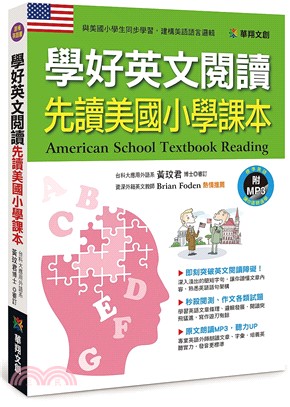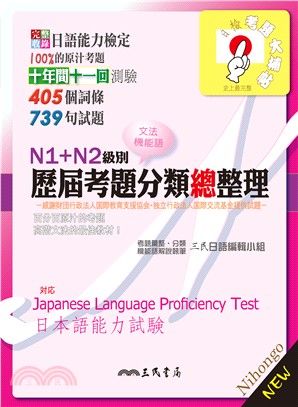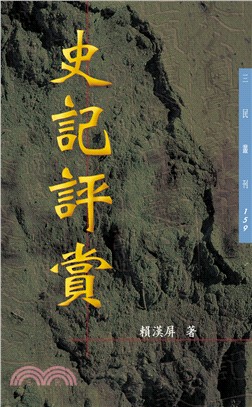商品簡介
即刻突破英文閱讀障礙!
深入淺出的簡短字句,搭配中文譯文及練習題,讓你讀懂文章內容,熟悉英語語句架構
秒殺閱測、作文各類試題
學習英語文章條理、邏輯發展,熟悉英語篇章結構,讓閱讀突飛猛進,寫作遊刃有餘
美式英文,內容原汁原味
本書收錄的所有內容(包括習題)均摘自美國小學課本,我們意欲讓讀者看到原汁原味的英語。
所選文章涉及面廣,豐富多采
文章內容極廣,包括自然科學、社會風土人情、語文、數學等,其中自然科學篇包括天文、地理、生物等知識體系,讓你在學習英語的同時,拓展知識、瞭解美國文化風情,增強英語學習的趣味性。
原文朗讀MP3,聽力UP
專業英語外師朗讀文章、字彙,培養英聽實力,發音更標準
名人/編輯推薦
★資深英語外國教師 Brian Foden 熱情推薦★
給親愛的讀者 / 學生 / 教師 :
身為一位多年從事於英語教學的外籍教師以及語文學習書的作者,我很樂意在此為大家推薦這本書。
學習外語的確非易事。它需要努力、專注、覆誦和將各種不同元素組織起來的批判性思考,以及耐心。市面上的許多學習書忽略了讓讀者有效學習的兩項關鍵因素。第一是有趣的內容,能讓讀者引起學習動機;另一個重要的因素是有系統組織架構的教材,足以幫助讀者理解和記憶此語言。當學生碰到無趣又缺乏系統的素材時,他們通常很難對學習內容產生興趣,即使勉強自己閱讀,終究難免放棄,而認為自己這方面的學習失敗了。事實上,是沒有選到正確的教材,不管是書籍、雜誌或學習錄影帶等。
正因為理解書市上的英語學習書品質不佳者眾,當我看到此書時,深感喜悅。這本書擁有許多優點,能讓讀者有效率充分學習。首先,編者精選了各種極好主題的文章,都是讀者深感興趣的,對於身為一位媒體人而言,挑選吸引人的篇章的確相當謹慎用心,文章不但呼應事實而且十分有趣。
此書先由自然科學篇開始,這部份的文章寫得非常好,包括寬廣的宇宙、肉食植物、地球、滅絕的恐龍等。社會篇則涵蓋了美國人的生活和歷史,這讓讀者更深入的了解美國文化。歷史篇則讀者/學生可以透過這些好文章,知道美國內戰、兩次世界大戰、以及經濟大蕭條等發生的重要緣由。
除了以上吸引人的主題之外,此書包含了一重要單元,語文篇。好似幫大家上了精采的文法課,教你如何撰寫段落和較長的故事。由於寫文章和報告甚至用英文寫電子郵件,都是普遍的需求,所以這些課程都是相當實用的。
而最棒的特色是這些選文與美國現今教育系統所採用的教材十分相近。這意味著此書所列舉的字彙反映了原汁原味的單字和片語,對於英語學習者很有助益,尤其是有志於出國留學者,這學習經驗更突顯其價值。
總而言之,這是一本非常有趣又實用的書籍,能幫助讀者∕學生輕鬆有趣的學習英文。
Brian Foden
資深外籍英語教師
目次
Science 自然科學
016 Hunter in the sky I-01 / 001 天空中的獵人
020 The Space Shuttle I-02 / 002 太空梭
025 Our Big Universe I-03 / 003 浩瀚的宇宙
030 Our Amazing Skin I-04 / 004 神奇的皮膚
034 Tears and More Tears I-05 / 005 眼淚
038 How does Nervous System Work I-06 / 006 神經系統如何運作
042 The Digestive System I-07 / 007 消化系統
046 Telltale Print I-08 / 008 能斷案的指紋
050 Meat-Eating Plants I-09 / 009 肉食植物
054 Stop that pacing, Fido I-10 / 010 費兜,安靜!
058 Secret Sharks I-11 / 011 神祕的鯊魚
062 Disappearing Dinosaurs I-12 / 012 滅絕的恐龍
066 Animal Partners I-13 / 013 動物界的夥伴關係
070 How Animals Sleep I-14 / 014 動物是怎樣睡覺的
074 Koalas I-15 / 015 無尾熊
078 Tales of Tail I-16 / 016 動物尾巴的作用
082 The Food Chains I-17 / 017 食物鏈
086 The Layer of Earth I-18 / 018 地層
089 Pollution I-19 / 019 污染
093 Energy I-20 / 020 能量
Society 社會
098 My America’s Freedoms II-01 / 021 美國的自由
103 Crazy Town, U.S.A. II-02 / 022 美國的瘋狂之城
107 How to Win a Prize II-03 / 023 如何得獎
111 How to Box the Gnat II-04 / 024 怎樣跳「棒打小昆蟲」
115 King of the Worms II-05 / 025 蟲子之王
118 How the Mail is Delivered II-06 / 026 信的流程
122 The Pony Express II-07 / 027 驛馬快遞
127 Money Doctors II-08 / 028 錢醫
131 Changes in Farming II-09 / 029 農業變革
135 Trains of the past II-10 / 030 火車的發展史
139 Umbrellas II-11 / 031 傘的發展史
143 Paper II-12 / 032 紙
147 The History of Kites II-13 / 033 風箏的歷史
151 Garden Art II-14 / 034 園林藝術
155 Yellowstone National Park II-15 / 035 黃石國家公園
159 Ferris’s Wheel II-16 / 036 費理斯的摩天輪
163 Tepees: Native American Homes II-17 / 037 圓錐帳篷—美國原住民的家
168 Olympic Games II-18 / 038 奧林匹克運動會
History 歷史
174 Columbus Discovers the New World III-01 / 039 哥倫布發現新大陸
178 The Pilgrims and Plymouth Colony III-02 / 040 清教徒和普利茅斯殖民地
182 The Boston Tea Party and the Declaration of Independence III-03 / 041
波士頓傾茶事件和《獨立宣言》
186 The American Revolution III-04 / 042 美國獨立戰爭
191 The Mexican War III-05 / 043 墨西哥戰爭
195 The Civil War III-06 / 044 美國內戰
201 World War I III-07 / 045 第一次世界大戰
206 The Great Depression III-08 / 046 大蕭條時期
212 World War II III-09 / 047 第二次世界大戰
218 The Cold War III-10 / 048 冷戰
222 The End of the Cold War III-11 / 049 冷戰結束
Language Art 語文
230 Synonym and Antonym IV-01 / 050 同義字和反義字
233 Kinds of Sentences IV-02 / 051 句子的類型
236 Present-Tense and Past-Tense Verbs IV-03 / 052 動詞的現在式和過去式
239 Analogies 類比
241 How to Write a Paragraph IV-04 / 053 如何寫段落
243 Story Order IV-05 / 054 故事順序
245 Book Report Writing IV-06 / 055 讀書報告
Mathematics 數學
250 Addition and Subtraction Operations & Three-digit Subtraction V-01 / 056
加法與減法運算&三位數減法
255 Problem Solving V-02 / 057 解決問題
259 Rounding off Numbers V-03 / 058 數字的四捨五入
260 Estimation of Sums V-04 / 059 概算總和
262 Multiplication and Division V-05 / 060 乘法和除法
264 The Meaning of Division V-06 / 061 除法的意義
266 Meaning of Fractions V-07 / 062 分數的意義
267 Meaning of Decimals V-08 / 063 小數的意義
268 Geometric Drawing V-09 / 064 幾何圖形
270 Area V-10 / 065 面積
271 Figures V-11 / 066 圖形
273 Money and Time V-12 / 067 金錢和時間
275 Elapsed Time V-13 / 068 經過的時間
Other Subjects 其他
278 Physical Education (PE) VI-01 / 069 體育課
281 One! Two! Three! Go! VI-02 / 070 一、二、三、開始!
282 Ready! Get Set! Pedal! VI-03 / 071 準備!踩好!開始蹬!
286 My America Songs VI-04 / 072 美國的歌曲
288 How to Decorate a T-Shirt VI-05 / 073 怎樣裝飾 T 恤
291 Make A Drum VI-06 / 074 鼓的製作
295 Pet Day at School VI-07 / 075 學校寵物日
296 Our Class Play VI-08 / 076 班級演出
書摘/試閱
自然科學Science
Hunter in the sky 天空中的獵人
Stargazing takes imagination. People who love stargazing see the stars as shinning spots in a dot-to-dot drawing game. They imagine lines that connect groups of stars called constellations. A constellation is a group of stars that looks like a person, an animal, or an object.
The constellation Orion is known as the hunter, after a hero from ancient Greek myths. To find Orion, first find the Big Dipper. The Big Dipper looks like a huge cup with a long handle. After you find the Big Dipper, turn around. There’s Orion! He is outlined by four bright stars that form two triangles. The tips of the triangles seem to come together. Where they meet, there are three more bright stars. These form Orion’s belt. Some fainter stars appear to hang from the belt. These are Orion’s sword.
Different kinds of stars are in the constellation Orion. The star Betelgeuse makes Orion’s bright shoulder. Betelgeuse is an Arabic word that means “shoulder of the giant.” The star itself is so huge that it is called a supergiant. Its diameter is 400 times greater than that of our Sun. Betelgeuse is considered a cool star. It is probably not as hot as our Sun.
Rigel is the star that makes Orion’s left foot. Rigel is the Arabic word for foot. Rigel is much brighter than Betelgeuse because it is much hotter. It’s more than three times as hot as our Sun. However, Rigel is just a baby is size compared to Betelgeuse.
A large, misty area near Orion’s sword is called a nebula. It is a mass of shining gas and dust. The gases whirl together and may form new stars. As the new stars begin to shine, Orion will be brighter than ever.
Words and Phrases:
stargaze ['stɑr͵gez] vi 眺望星星;凝視
imagination [?͵mædʒə'ne?ən] n. 想像力;空想,想像
drawing game 塗塗畫畫;畫圖遊戲
constellation [͵kɑnstə'le?ən] n. 星座
Orion [o'ra?ən] n. 獵戶星座
Big Dipper 北斗七星
outline ['a?t͵la?n] vt. 畫(標)出……的輪廓
triangle ['tra?͵æ?g!] n. 三角形
faint [fent] adj. 微弱的,暗淡的,模糊的
Betelgeuse n. 獵戶星座中的一等星
Arabic ['ærəb?k] adj. 阿拉伯的;阿拉伯語的;阿拉伯人的
supergiant ['supɚ͵dʒa?ənt] adj. 特大的,超巨型的;n. 超巨星
diameter [da?'æmətɚ] n. 直徑
Rigel ['ra?dʒəl] n. 參宿七
misty ['m?st?] adj. 多霧的,被霧籠罩的
nebula ['n?bj?lə] n. 星雲;星雲狀的星系
whirl [hwɝl] vi 旋轉
Practice:
1. When looking at the constellation, people try to imagine .
A. lines B. games C. spots D. groups
2. Groups of stars are called .
A. stargazers C. ancient myths
C. constellations D. connections
3. The four bright stars in Orion form .
A. a big cup B. two triangles C. a long handle D. an animal
4. Betelgeuse makes .
A. Arabic words B. Orion’s shoulders
C. different stars D. huge sizes
5. Orion may shine brighter .
A. when Rigel explodes B. as new stars shine
C. as dust shines D. as dust forms
譯文:
天空中的獵人
眺望星空需要想像力。喜歡遠眺星空的人們往往把星星看作是連點畫圖遊戲中閃亮的點。他們想像群星間有線條相連以組成星座。星座就是看上去像人、動物或物體的一組星星。
獵戶星座看上去就像個獵人,源於古代希臘神話中的一個英雄。要找到獵戶座,首先得找到北斗七星。北斗七星看上去像一個有著長長把手的大杯子。找到北斗七星後,轉身,就會找到獵戶星!它由四顆亮星組成兩個三角形。三角形的頂端看上去連接在一起,在它們相連接的地方,有三個更亮的星星,它們組成獵戶座的腰帶。懸掛在腰帶上一些微暗的星星是獵戶座的寶劍。
獵戶座由不同種類的星星組成。β星組成獵戶座明亮的肩膀。Betelgeuse在阿拉伯語中的意思是「巨人的肩膀」。 β星很大,以致於被稱作超巨星,直徑是我們太陽的400倍。β星被視為冷恆星,它的溫度似乎沒有太陽的溫度那麼高。
參宿七星組成獵戶座的左腳,Rigel在阿拉伯文語中代表的意思是「腳」。參宿七星看上去比β星亮,因為它的溫度很高,是我們太陽溫度的三倍。然而就大小而言,參宿七和β星相比,簡直如嬰兒一般。
在獵戶座寶劍一大片霧狀區域被稱為星雲。它是發光的氣體和灰塵的混合物。這些氣體旋轉在一起,可能還會形成新的星體。當新生成的星星閃爍的時候,獵戶座會比現在更明更亮。
練習:
1. 在看星座的時候,人們試圖想像星星之間有 .
A.線條 B. 遊戲 C.斑點 D.成群的
2. 成群的星星被稱為 .
A. 占星師 B. 古代神話 C. 星座 D. 聯結體
3. 在獵戶星座?,四顆明亮的星星組成 .
A.一個大杯子 B. 兩個三角形 C. 一個長長的手柄 D. 一隻動物
4. β星組成 .
A.阿拉伯語言 B. 獵戶座的肩膀 C.不同的星星 D. 巨大的面積
5. 獵戶星或許會更明亮。
A. 當參宿七爆炸時 B.當新星星開始閃爍時 C. 當灰塵發光時 D.當灰塵形成時
答案:
1. A 2. C 3. B 4. B 5. B
The Space Shuttle 太空梭
Space shuttles go back and forth between Earth and space. The first one flew on April 12, 1981. A space shuttle has four main parts. They are the orbiter, the fuel tank, and two rocket boosters.
The orbiter looks like an airplane. It carries the crew. A huge tank is attached to the orbiter. It holds fuel for the orbiter’s engines. A rocket booster is on each side of the tank. These fire on liftoff. In two minutes, the rockets run out of fuel and fall off. Parachutes slow their drop to the sea. Then boats tow them to shore. Rockets can be used as many as 20 times. The big tank runs out of fuel in eight minutes. It falls and breaks apart over the sea. Now the orbiter enters its orbit.
There may be up to seven crew members on board the orbiter. They do tests. They might launch satellites. In 1999, a shuttle went up to fix the Hubble telescope. The Hubble is as big as a bus. The shuttle caught it. The telescope was held in the cargo bay. That’s an open place like the back of a pickup truck. The crew worked out in space to make repairs. They wore space suits. They were attached to the shuttle by a long line. A robot arm put the Hubble back in orbit.
When it’s time to come home, the orbiter’s engines fire. This slows the shuttle, and it drops from orbit. Tiles protect the shuttle from heat caused by entering Earth’s atmosphere. The shuttle then acts like an airplane. It glides to a landing on a runway.
Words and Phrases:
space shuttle 太空梭
orbiter ['?rb?tɚ] n. 軌道飛行器
fuel tank 燃料箱
rocket booster 火箭加速器;火箭助推器
run out of 用完
parachute ['pærə͵?ut] n. 降落傘
tow [to] vt. 拖,拉
orbit ['?rb?t] n. 軌道
launch [l?nt?] vt. 發射
satellite ['sæt!͵a?t] n. 衛星;人造衛星
Hubble telescope 哈伯望遠鏡
cargo bay 貨倉
pickup truck 小型載貨卡車
robot arm 機械手臂
atmosphere ['ætməs͵f?r] n. 大氣,大氣層
glide [gla?d] v.(使)滑行,滑翔
runway ['rʌn͵we] n.(機場的)跑道
Practice:
1. When do the rocket boosters fire?
A. while the orbiter is circling Earth
B. right before landing
C. on liftoff
2. When does the orbiter enter its orbit?
A. after the big fuel tank falls to the sea
B. when the parachutes open
C. after a satellite is launched
3. When was the telescope held in the cargo bay?
A. before 1999
B. after the shuttle caught it
C. after a robot arm put it in orbit
4. When do the orbiter’s engines fire?
A. when it’s time to return to Earth
B. before it reaches orbit
C. when the crew works out in space
譯文:
太空梭
太空梭是在地球與太空之間來回穿梭的機器。太空梭第一次發射是在1981年4月12日。一具太空梭由四部分組成:軌道飛行器,燃料箱和兩個火箭助推器。
軌道飛行器看上去像一架飛機,它承載著工作人員。巨大的燃料箱與飛行器相連,裡頭裝著飛行器發動機所需的燃料。火箭助推器連接在燃料箱的兩側,它們在起飛時點燃。火箭助推器在兩分鐘內將燃料用盡,就從高空掉落。降落傘裝置讓它緩慢墜入大海,再由船隻拖回海岸。火箭能夠這樣重複使用二十次左右。巨大的燃料箱在八分鐘後也會將燃料用盡,它從高空墜落分解並入大海。此時軌道飛行器則順利進入軌道。
軌道飛行器最多能承載七名做測驗的工作人員。他們或許也會發射人造衛星。1999年,一架太空梭被派往太空去修復哈伯天文望遠鏡。哈伯望遠鏡如同一輛公車般大小。大空梭首先扣住哈伯望遠鏡,隨後把它固定在貨艙裡。貨艙是開放空間,就像無頂載貨卡車後面的部分。工作人員得在太空梭外的太空修復它,他們身穿太空服,並用一條長長的繩索與太空梭相連。修理完後,機械手臂把哈伯望遠鏡放回軌道上。
當飛行器從太空返航時,要點燃軌道飛行器的發動機,此舉減緩太空梭的速度,使其脫離軌道進入地球大氣層,這時太空梭外部的特製陶片保護太空梭免受地球大氣層的高溫。最後太空梭就會像飛機一樣,滑翔並降落在跑道上。
練習:
1.火箭助推器什麼時候點燃?
A.當飛行器圍繞地球旋轉時
B.恰好在著陸前
C.在起飛時
2.什麼時候飛行器進入軌道?
A.在巨大的燃料箱墜入大海後
B.當降落傘打開時
C.在衛星發射後
3.什麼時候哈伯望遠鏡被固定在貨艙裡?
A.在1999年前
B.當太空梭扣住它後
C.在機器手把它放回軌道後
4.什麼時候點燃飛行器的發動機?
A.當飛機器返回地球時
B.在它到達軌道之前
C.當工作人員在太空工作時
答案:
1.C 2. A 3. B 4. A
Our Big Universe 浩瀚的宇宙
For many years people have had questions about the universe. In ancient times they thought the world rested on the back of an elephant. When asked what the elephant stood on, they answered, “on the back of a turtle.” Most ancient people believed the sun, moon, and stars revolved around the earth. Some also taught that the earth was flat because to them it looked that way. They were afraid that if one went too far in any direction, he would fall off the edge.
These beliefs, in the form of legends, myths, and stories, were accepted as facts when they really were opinions. Opinions are beliefs that people have without positive knowledge or proof. The fact that God created the universe has, even today, been ignored by many persons. Instead, they have accepted opinions and ideas to replace the truth that God has revealed in the Bible.
The astronomers’ eyes. About three hundred seventy years ago an instrument was made to help scientists learn more about space. The story has been told about a Dutchman who made eyeglasses. His name was Hans Lippershey. One day, unknown to him, his children slipped into the shop where he worked. They began to play with some glass lenses. One of the children picked up two lenses and looked out the window. He was surprised at what he saw. He noticed that a church which was far away looked much closer and bigger. He called his father. His father rushed in and was amazed at what he saw. By chance Hans’ son had made a very important discovery. He had discovered that if he held a lens near his eye and another lens a little farther away, objects at a distance appeared to be much closer and bigger than they really were. A short time later an Italian scientist named Galileo, heard about this discovery. He started at once to use two lenses and made a telescope.
Since the time Lippershey and Galileo made their first telescopes in 1608 and 1609, scientists have made larger and better ones. The telescope has opened new worlds in astronomy. With telescopes astronomers can see farther and farther into space.
Another instrument that has aided in space study is the spectroscope. A spectroscope measures light from heavenly bodies. When you see a rainbow in the sky you are looking at a type of spectroscope. The light of the sun shining on the drops of water is broken into the colors of the rainbow. A spectroscope works like the raindrops to break up the colors of light from faraway heavenly bodies. By using a spectroscope with a telescope, and astronomer can learn important information about the stars.
Astronomers use another important instrument called a radio telescope to study the universe. The radio telescope is used to receive radio signals from stars and other objects in space. These radio signals are called waves.
A machine attached to the radio telescope strengthens the signals and records them as wavy lines on a piece of paper. The wavy lines tell the astronomer the distance to the object and where it is located in space. In this way, the astronomer gets the information from stars that are so far away and so dim that they cannot be seen through a regular telescope.
From these instruments, astronomers can get the needed information to make maps of the heavenly bodies.
Words and Phrases:
ancient ['en?ənt] adj.古代的,古老的
turtle ['tɝt!] n. 海龜,甲魚
revolve [r?'vɑlv] v.(使)旋轉
fall off 跌落
legend ['l?dʒənd] n. 傳說,傳奇故事
ignore [?g'nor] vt.不顧,不理,忽視
replace [r?'ples] vt. 取代,代替
astronomer [ə'strɑnəmɚ] n. 天文學家
instrument ['?nstrəmənt] n. 器具,儀器
slip into 悄悄進入
by chance 偶然地,意外地
astronomy [əs'trɑnəm?] n. 天文學
spectroscope ['sp?ktrə͵skop] n. 光譜儀
heavenly bodies 天體
rainbow ['ren͵bo] n. 彩虹
break into 把……分成
break up 分解
radio telescope n. 電波望遠鏡;無線電望遠鏡
radio signal 無線電信號
wavy ['wev?] adj. 波狀的;起伏的;有波紋的
Practice:
1. Many ancient people believed that the earth rested on the back of .
A. a dog B. a bird C. an elephant D. a cat
2. This belief in 1 was widely accepted as by many.
A. fact B. proof C. silly D. unbelievable
3. Theories and ideas of men have often replaced the of God’s Word.
A. error B. mistakes C. truth D. uncertainty
4. An Italian scientist who improved upon the telescope and made it popular was
A. Lippershey B. Galileo C. Marconi D. none of these
譯文:
浩瀚的宇宙
長久以來,人們對宇宙一直存有很多疑問。古時候的人認為地球就位在大象的背上。當被問到大象站在什麼上面時,古人又回答「在龜背上」。大部分的古人認為太陽、月亮、星星都繞著地球旋轉。一些人也認為地球就如同他們看到的一樣是扁平的。如果有人向任何一個方向走得太遠,大家就會擔心他會從地球邊緣跌下去。
這些信念以傳說、神話以及故事的形式被那時的人們當作是事實所接受,儘管它們真的只是觀點而已。觀點就是人們根據沒有明確知識或證據的信念。即使在今天,上帝創造宇宙的事實仍然被很多人所忽略。相反的,這些觀念和想法還會取代上帝在聖經裡揭示的真理,而被人們所接受。
大約在370年前,一種幫助科學家更了解太空的工具「天文學家之眼」誕生了。故事是講一個名叫漢斯‧李普希的荷蘭人,他專門製造眼鏡。某天,他的孩子們瞞著父親悄悄溜進工作的店鋪,去把玩一些玻璃鏡片。其中一個孩子拿起兩片透鏡朝窗外望去。他非常吃驚地發現遠處的教堂看上去竟然那麼近那麼大。他便叫父親來看。父親匆忙跑來,對所看到的無比驚訝。就這樣,漢斯的兒子偶然間有了一項重大發現。他發現如果一個鏡片貼近眼睛,而把另一個鏡片稍微拿遠一點,那麼遠處的物體看上去就會比實際的大許多也近許多。不久之後,一位名叫伽利略的義大利科學家聽說了此項發明,就立即著手用兩片透鏡製造出了望遠鏡。
自李普希於1608年和伽利略於1609年製造出他們的第一個望遠鏡後,科學家們陸續製造出更大更好的望遠鏡。正是望遠鏡打開了通向天文世界的大門。有了它們天文學家能在太空中看得更遠。
光譜儀另一個有助於太空研究的得力工具,它能夠測量來自天體的光線。當你看到彩虹在天空出現時,事實上你就看到了一種光譜儀。照在水滴上的太陽光線被分解成彩虹的七彩顏色。光譜儀的工作原理就像雨滴,它把來自天體的光線分解成不同的顏色。通過運用光譜儀、望遠鏡,天文學家可以獲悉有關星體的重要資訊。
無線電望遠鏡是天文學家研究宇宙的另一種重要的儀器。這種望遠鏡用來接收來自太空的星體或其他物體的無線電信號。這些無線電信號叫做「波」。
一台與無線電望遠鏡相連的機器能強化信號,並以波狀線條的形式記錄在紙上。通過研究這些波狀線,天文學家可以知道物體的距離以及確定它在太空的位置。用這種方法,天文學家可以獲得那些用普通望遠鏡看不到的、距離地球遙遠而又暗淡的星體的資訊。
有了這些儀器的幫助,天文學家們可以獲取需要的資訊來繪製天體圖。
練習:
1. 古時候很多人相信地球坐落在 背上。
A.一隻狗 B.一隻鳥 C. 一頭大象 D. 一隻貓
2. 許多人認為1這種信念是 。s
A.事實 B.證據 C.愚蠢的 D.不可思議的
3. 當時的理論和觀點完全取代了聖經所講述的 。
A.過失 B.錯誤 C. 事實 D.不確定
4. 改進望遠鏡並促使它廣泛使用的一位義大利科學家是 。
A.李普希 B.伽利略 C.馬可尼 D.都不是
答案:
1.C 2.A 3.C 4. B
主題書展
更多書展今日66折
您曾經瀏覽過的商品
購物須知
為了保護您的權益,「三民網路書店」提供會員七日商品鑑賞期(收到商品為起始日)。
若要辦理退貨,請在商品鑑賞期內寄回,且商品必須是全新狀態與完整包裝(商品、附件、發票、隨貨贈品等)否則恕不接受退貨。
























